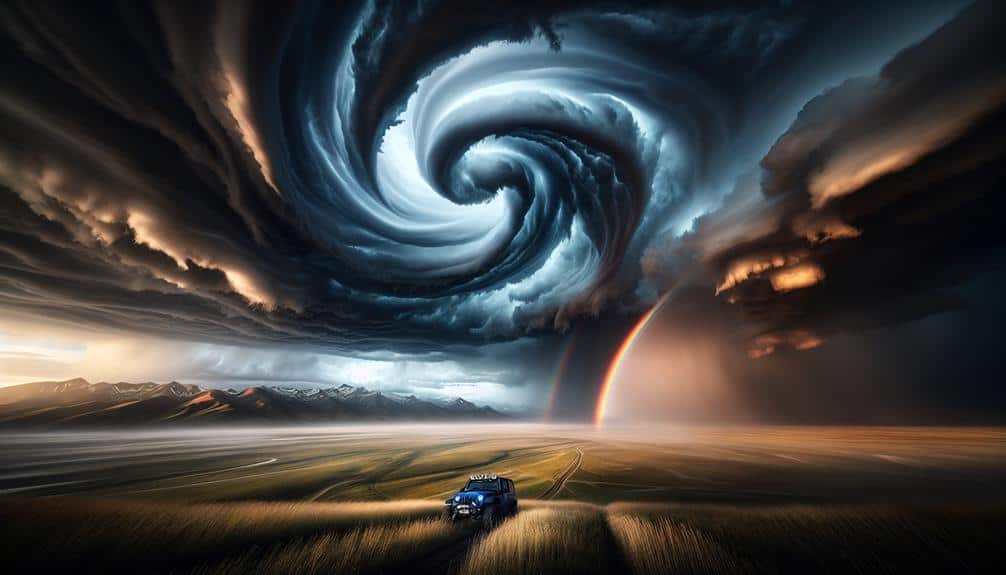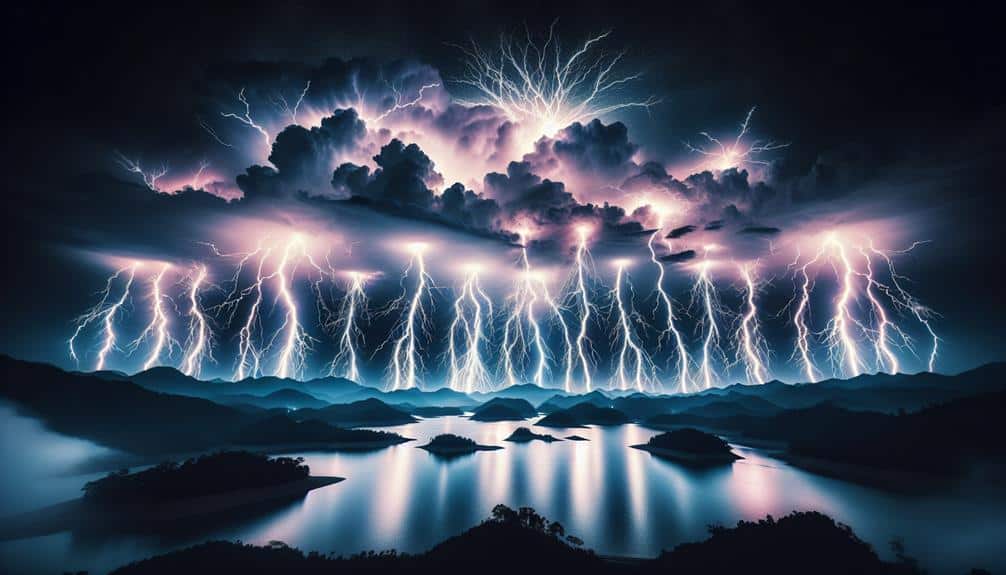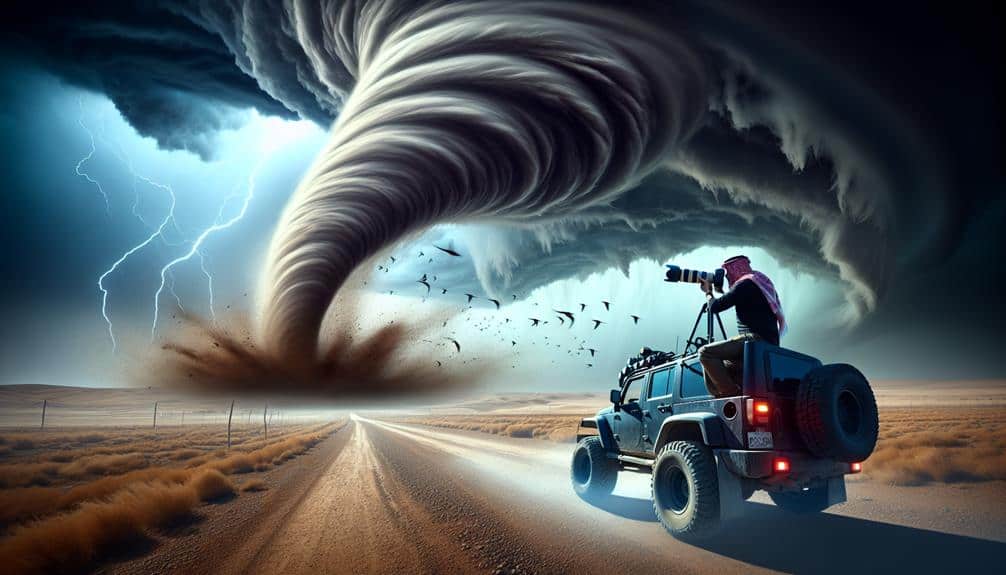As storm chasers, we harness advanced meteorological tools and techniques to capture the fleeting beauty of rainbows. By analyzing atmospheric conditions, such as humidity and wind patterns, we pinpoint the best times and locations for photographing rainbows. Polarizing filters reduce glare while optimal camera settings enhance color capture. Our safety is paramount, so we equip ourselves with weather-sealed gear and real-time storm tracking tools. Ideal chase locations include coastal areas and mountain ranges, where weather patterns favor rainbow formation. If you're enthusiastic to understand the confluence of these elements and the science behind capturing this phenomenon, you'll find detailed insights here.
Key Points
- Analyze atmospheric conditions and weather patterns to predict ideal rainbow viewing locations and times.
- Use polarizing filters to reduce glare and enhance rainbow colors in photographs.
- Adjust camera settings with low ISO, wide aperture, and fast shutter speed for optimal rainbow capture.
- Monitor real-time storm prediction models and radar imagery to track storm formations accurately.
The Thrill of the Chase
In our pursuit of capturing rainbows, we meticulously analyze atmospheric conditions to predict best viewing times and locations. Our data-driven approach begins with examining weather patterns to identify storm formations that typically precede rainbow appearances. This involves studying humidity levels, wind patterns, and precipitation forecasts.
The anticipation of witnessing such natural beauty provides an adrenaline rush that fuels our commitment to this endeavor.
To maximize the chances of capturing a rainbow, we employ several photography tips. First, we use polarizing filters to reduce glare and enhance the vibrancy of the rainbow's colors. Second, maintaining a low ISO setting is vital for minimizing noise and ensuring sharp images. Third, we adjust the aperture to achieve a suitable depth of field, allowing the rainbow to stand out against the stormy backdrop.
Understanding storm formations is essential. Rainbows often appear when sunlight penetrates droplets of water in the atmosphere at specific angles, typically during the late afternoon or early morning. By situating ourselves strategically, we can capture the full arc of the rainbow, with the storm providing a dramatic contrast.
This blend of scientific precision and artistic passion enables us to immortalize these fleeting moments of natural beauty.
Perfect Timing Essentials
Mastering the art of capturing rainbows hinges on precise timing, leveraging our understanding of solar angles and atmospheric conditions. To achieve this, we need a robust chasing strategy that incorporates detailed knowledge of weather patterns and forecast accuracy. By analyzing meteorological data, we can predict when and where rainbows are likely to form. Specifically, we focus on post-storm scenarios where the sun breaks through clouds, creating the perfect conditions for rainbow formation.
Our chasing strategy involves real-time monitoring of storm prediction models and radar imagery. We prioritize regions with a high probability of sudden, intense rainfall followed by immediate sunlight. To maximize our chances, we track the sun's position, ensuring it's at an ideal angle—typically 42 degrees above the horizon. This scientific approach allows us to anticipate the precise moments when rainbows will appear.
Accurate storm prediction is vital for this endeavor. We rely on advanced weather forecasting tools to pinpoint the exact timing of clearing skies. This precision enables us to position ourselves in best locations, ready to capture the fleeting beauty of rainbows.
Gear for Success
To enhance our rainbow-chasing endeavors, we must prioritize essential chasing equipment and reliable weather tracking tools. High-quality cameras with wide dynamic range and durable tripods are critical for capturing vibrant images.
Additionally, leveraging advanced meteorological software enhances our ability to predict best rainbow conditions with precision.
Essential Chasing Equipment
Frequently, success in capturing rainbows hinges on the precise selection and utilization of specialized chasing equipment. Our camera settings must be meticulously calibrated to ensure ideal exposure and color balance. Adjusting the ISO, aperture, and shutter speed can make the difference between a washed-out image and a vibrant, full-spectrum capture. We recommend a low ISO setting of 100-200 to minimize noise and a wide aperture (f/8-f/16) to maintain sharpness across the rainbow's arc. A fast shutter speed is essential to freeze the fleeting moment when light refracts perfectly through raindrops.
Equally critical is vehicle maintenance. Our mobility is our freedom, and a well-maintained vehicle ensures we can chase storms safely and efficiently. Regular checks on tire pressure, oil levels, and brake functionality are non-negotiable. High-quality all-terrain tires provide the necessary traction, while a robust suspension system can handle the rugged off-road conditions often encountered during a chase. A reliable GPS system and updated road maps are indispensable for finding the best routes.
Weather Tracking Tools
Understanding the science behind rainbows requires sophisticated weather tracking tools to predict when and where these phenomena will appear. We rely heavily on satellite imagery and radar tracking to gather real-time data on storm development and movement. These tools provide us with high-resolution images and precise measurements of precipitation, which are essential for accurate storm prediction.
Satellite imagery offers a macro perspective, allowing us to monitor large-scale weather patterns and cloud formations. This data is invaluable for identifying potential storm systems that could produce the necessary conditions for rainbows. Coupled with radar tracking, we can obtain detailed information on precipitation intensity and movement, enabling us to pinpoint areas where rainfall and sunlight might intersect.
Our forecasting tools are vital for making timely decisions. Using advanced algorithms, we analyze historical weather data and current atmospheric conditions to predict storm trajectories. These tools give us the freedom to chase storms with greater precision and safety, ensuring we're in the right place at the right time to capture the fleeting beauty of a rainbow.
In essence, the combination of satellite imagery, radar tracking, and sophisticated forecasting tools empowers us to decode the mysteries of weather and seize the opportunity to witness nature's most colorful displays.
Safety Precautions
Let's prioritize safety by ensuring we have the proper gear essentials and stay informed about weather conditions.
Wearing non-slip footwear and carrying waterproof equipment can prevent accidents and device damage.
Monitoring real-time weather data helps us avoid hazardous situations while maximizing our chances of capturing rainbows effectively.
Proper Gear Essentials
Securing the correct gear when capturing rainbows is crucial to both our safety and the success of our fieldwork. Proper preparation allows us to navigate unpredictable weather conditions and capture stunning images efficiently. Waterproof clothing is essential for maintaining body temperature and preventing hypothermia during prolonged exposure to rain.
Our camera gear must be weather-sealed to protect against moisture and debris, ensuring we obtain clear, high-quality shots.
Equipping ourselves with the latest technology tools can greatly enhance our fieldwork. Devices such as GPS units and weather tracking apps help us stay informed and make real-time decisions. An emergency kit, containing first aid supplies and survival essentials, is non-negotiable. It ensures we're prepared for any unforeseen circumstances.
Here's a rundown of our essential gear:
- Waterproof clothing: Keeps us dry and warm, crucial for extended exposure.
- Weather-sealed camera gear: Shields our equipment from the elements.
- Technology tools: GPS, weather apps, and communication devices for real-time updates.
- Emergency kit: First aid, survival essentials, and emergency contacts.
Weather Condition Awareness
While our gear equips us for the field, staying vigilant about weather conditions is vital for our safety and photographic success. We must leverage cutting-edge meteorological forecasting tools to anticipate severe weather events accurately. Understanding these tools allows us to track storm systems, gauge precipitation levels, and monitor wind speeds. Climate change has rendered weather patterns increasingly erratic, making real-time updates essential.
Emergency preparedness is another crucial element in our arsenal. We should establish clear evacuation routes and keep emergency kits ready, including first aid supplies, communication devices, and sufficient food and water. Real-time data analysis helps us identify potential threats, such as tornadoes or flash floods, and act swiftly to minimize risks.
Moreover, understanding the environmental impact of our activities is vital. We must guarantee our presence doesn't exacerbate fragile ecosystems already stressed by climate change. Utilizing digital platforms to share our findings can also inform broader audiences, fostering a collective responsibility toward environmental stewardship.
Ideal Locations

For best rainbow sightings, we need to focus on locations with frequent rainfall and ample sunlight, such as coastal regions and mountainous areas. These environments maximize our chances of observing and capturing vivid rainbows. By examining meteorological data, we can identify top destinations for storm chasing that also serve as picturesque spots for rainbow hunting.
To optimize our rainbow sightings, we should consider:
- Coastal Areas: High humidity and frequent showers make coastal regions prime for rainbows.
- Mountain Ranges: Elevation changes lead to varied weather patterns, enhancing rainbow formation.
- Tropical Regions: Consistent rainfall and sunlight provide ideal conditions.
- Northern Latitude Areas: Longer twilight hours increase the window for rainbow visibility.
Understanding these locations allows us to plan our expeditions with scientific precision. For instance, the Pacific Northwest is renowned for its frequent rain showers and stunning coastal views, making it a haven for rainbow hunters.
Similarly, the Rocky Mountains offer dramatic backdrops and variable weather, perfect for storm chasing and rainbow photography. By targeting these scientifically validated locations, we maximize our opportunities to capture the elusive beauty of rainbows, fulfilling our quest for freedom and exploration.
Sharing the Experience
Sharing our rainbow hunting experiences not only enriches our community but also contributes valuable data to the broader scientific study of meteorological phenomena. By documenting our chasing techniques and photography tips, we create a repository of knowledge that others can utilize and build upon. Our collective observations help refine predictive models, enhance understanding of atmospheric conditions, and improve the accuracy of weather-related research.
Effective chasing techniques, such as monitoring Doppler radar to track storm movement and using GPS for precise location data, are essential. Equally important are photography tips, like using a polarizing filter to enhance the rainbow's vivid colors or adjusting exposure settings to capture the ethereal glow at best moments. Sharing these insights through community support channels and online resources fosters a collaborative environment where everyone can thrive.
Engaging in online resources like specialized forums, social media groups, and dedicated apps allows us to connect with fellow storm chasers. These platforms offer real-time data sharing, troubleshooting advice, and moral support. By participating in these networks, we not only gain valuable information but also contribute to a dynamic, self-sustaining community that values both freedom and scientific inquiry.
Frequently Asked Questions
How Do Storm Chasers Predict Where Rainbows Will Appear?
We predict where rainbows will appear by analyzing weather patterns and the sun's position. Using rainbow angles and understanding rainbow reflection, we can determine the best vantage points for capturing these natural phenomena with precision.
What Are the Best Times of Year for Capturing Rainbows?
For capturing rainbows, we prioritize Spring and Summer due to increased rainfall and sunlight angles. Autumn offers occasional opportunities, but Winter's limited sunlight and precipitation reduce frequency. Data shows ideal conditions correlate with post-storm sunlight exposure.
How Do Weather Conditions Affect Rainbow Formation?
Weather conditions greatly influence rainbow formation. Light refraction occurs at its best with specific atmospheric conditions, like post-rain sunshine and low-angle sunlight. Humidity and cloud cover also impact visibility, making these factors essential for capturing rainbows successfully.
What Camera Settings Work Best for Photographing Rainbows?
For photographing rainbows, we need to think about lighting conditions and exposure settings. Using a wide-angle lens captures the full arc. Post-processing techniques enhance colors. Adjusting exposure settings guarantees clarity, given the varied lighting conditions.
Can You Capture Rainbows at Night or in Low-Light Conditions?
In the moonlit tapestry of night photography, capturing rainbows requires mastering low light techniques. While it's challenging, using long exposure, high ISO, and wide apertures can reveal their elusive beauty against the starlit canvas.


